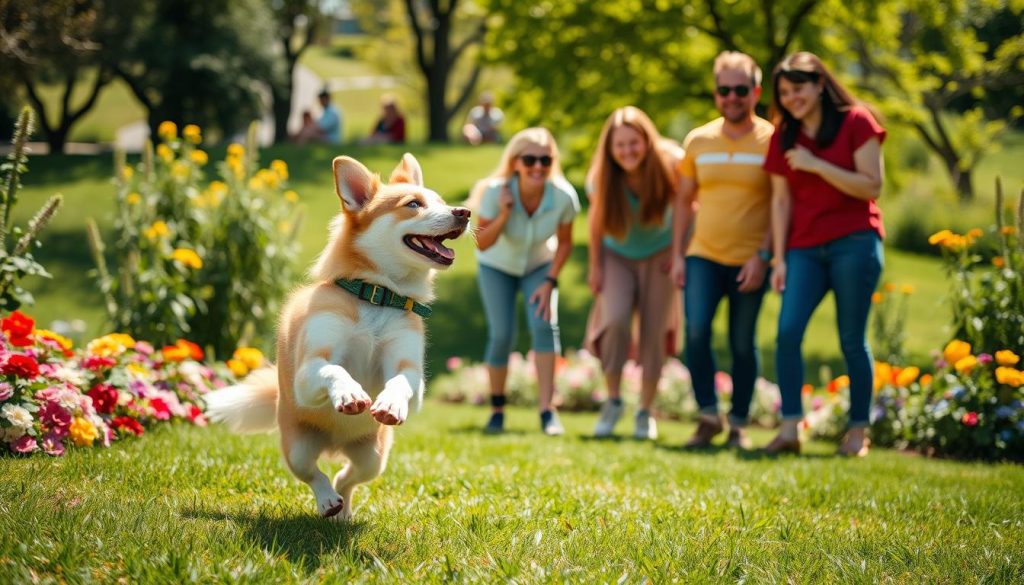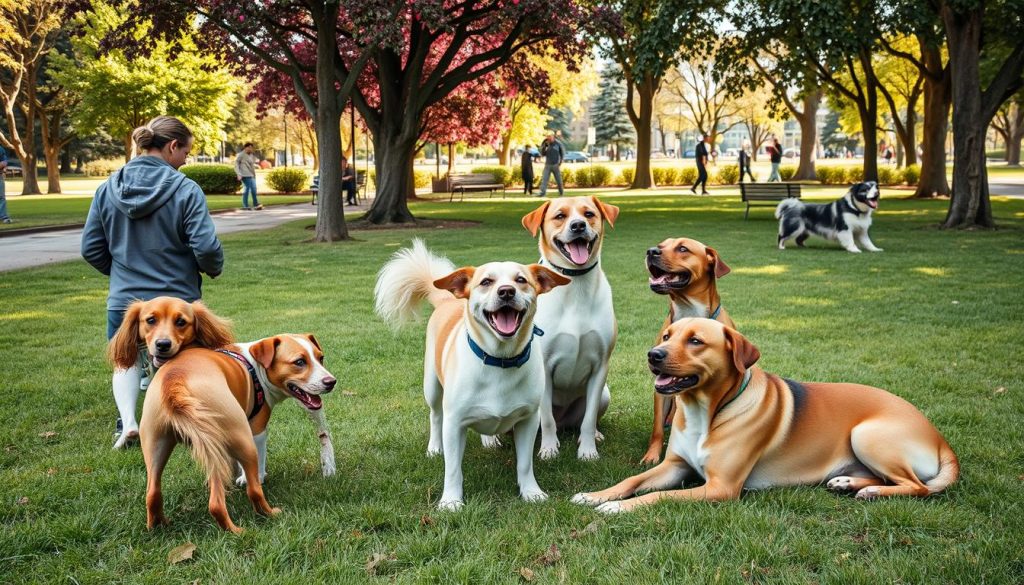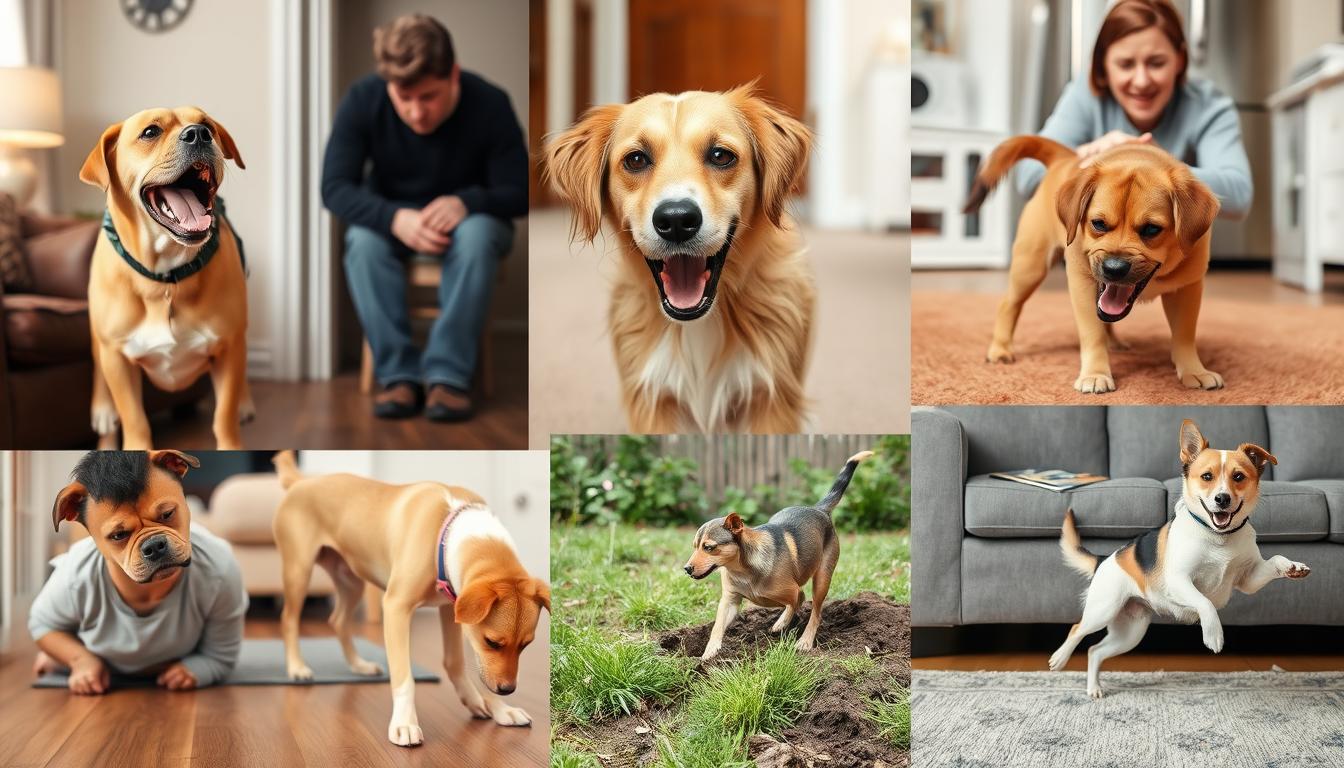Ever wondered why your furry friend acts in ways that puzzle or frustrate you? The answer lies in understanding dog behavior problems and their causes. This article will cover common issues, their roots, and solutions to improve your bond with your dog.
Where do these problems come from, and how can you fix them? Find out as we explore dog behavior. We’ll uncover the secrets to a happier, healthier relationship with your pet.
Common Dog Behavior Issues
As pet owners, we often face dog behavior problems that are frustrating and concerning. These include destructive behavior, like chewing on household items, and barking that disrupts the neighborhood. Even when dogs jump up on people, it can be a challenge. Understanding why these behaviors happen and finding effective training is crucial.
Destructive behavior, like chewing on furniture or shoes, is common. It can be due to boredom, lack of exercise, or separation anxiety. Teaching dogs to chew on toys and providing enough physical and mental stimulation can help.
Excessive barking is another issue, whether it’s constant yapping or sudden outbursts. It might be caused by noises or strangers. Finding out what triggers the barking and addressing it can help.
Dogs jumping up on people is also a common problem. It can be annoying and even dangerous, especially for kids or the elderly. This behavior often seeks attention or excitement. Training that rewards calm behavior and discourages jumping can help.

Quick Recommendation : Our blog is filled with tips , tricks, and methods for training your dog. If you would like a Free Dog Training Workshop , we recommend the K9 Training Institute.
Understanding the reasons behind these behaviors and using the right training can solve these problems. This way, dogs can become well-behaved, obedient, and a joy to have at home.
Identifying the Root Causes
Understanding why your dog acts out is key to solving the problem. Issues can come from boredom, not enough exercise, bad socialization, or health problems.
Boredom is a big reason for dog behavior issues. Dogs need to think and move to be happy. If they’re bored or not active enough, they might act out.

Quick Recommendation : Our blog is filled with tips , tricks, and methods for training your dog. If you would like a Free Dog Training Workshop , we recommend the K9 Training Institute.
Not socializing dogs enough can also cause problems. Puppies need to meet people and animals to grow right. Without this, they might become scared, anxious, or aggressive.
Health issues like thyroid problems, pain, or brain disorders can also show up as bad behavior. If you’ve checked other reasons, see your vet. They can check if your dog’s behavior is due to a health issue.
Understanding Dog Behavior Problems: Causes and Solutions
Dealing with dog behavior issues can be tough but rewarding. Knowing why your dog acts out helps you fix the problem. Common reasons include not socializing enough, poor training, environmental issues, and health problems.
Finding the cause of your dog’s behavior is key. This might mean getting professional help, changing your lifestyle, or using special training methods. With time and the right approach, you can tackle many issues, like too much barking or aggression.
Issues like anxiety, fear, or potty training problems have solutions. Understanding the reasons and using the right fixes can make your dog happier and your bond stronger. Remember, solving dog behavior problems takes time and effort. But with the right help and commitment, you can overcome any challenge.
Anxiety and Fear-Related Behaviors
As pet owners, we often see dog anxiety behaviors and fear-related issues in our pets. These emotional challenges can show up in many ways. This includes excessive barking, destructive tendencies, and even aggression. It’s important to understand what causes these behaviors to help our dogs feel better.
Separation anxiety is a big problem for dogs. They get very upset when left alone. This can lead to loud barking, going to the bathroom where they shouldn’t, and even hurting themselves. Dogs can also be scared of loud noises like thunderstorms or fireworks. To help, we need to be patient and use special training methods.
Understanding why your dog is scared and using the right training can make a big difference. Talking to an animal behaviorist or vet can help you create a plan for your dog. With the right help, your dog can overcome their fears and live a happier life.
Aggression in Dogs
Dealing with dog aggression can be tough for pet owners. There are different types of aggression, like territorial, resource guarding, and redirected. Knowing the causes and using the right training is key to solving these problems.
Territorial aggression makes a dog defend their space, like home or yard. Resource guarding happens when a dog gets too attached to things like food or toys. Redirected aggression is when a dog attacks someone or another animal, even if it’s not the real reason.
To handle dog aggression, finding the root cause is crucial. Working with a professional trainer or animal behaviorist is important. Positive training, desensitization, and counter-conditioning can help manage aggression. Also, a safe and interesting environment, along with addressing health and mental issues, can prevent aggression.
Potty Training Challenges
Potty training a dog can be tough, but it’s key to being a good pet owner. Many dog owners struggle with house-training their pets. This section will look at common problems and how to solve them.
One big issue is dog marking behavior. Dogs pee in the house, like on walls or furniture, to claim their territory. To fix this, you need patience and consistent training. Find out what triggers it, limit access to problem spots, and reward good potty behavior.
House-training regression is another challenge. It’s when a dog that was trained well starts having accidents again. This can happen due to stress, changes, or health issues. To fix it, go back to the basics of potty training. Take your dog out more often and watch their behavior closely.
Submissive urination is also a problem for some owners. It’s when a dog pees out of fear or anxiety, like when scolded or meeting new people. To solve this, build your dog’s confidence and use positive training methods.
Knowing the common potty training issues and using the right strategies can help. You can make sure your dog is well-trained and happy at home.
Separation Anxiety in Dogs
Many dogs suffer from separation anxiety, a distressing behavior problem. It causes destructive and vocalized behaviors when left alone. Knowing the signs and how to help can greatly improve your dog’s wellbeing and your peace of mind.
Excessive barking, whining, or howling when you leave are key signs. Your dog might chew, dig, or scratch to escape. They may also pace, pant, or have accidents in the house.
Separation anxiety can come from lack of socialization, routine changes, or past traumas. Positive reinforcement training can help. Gradually getting your dog used to being alone and providing engaging toys are effective.
Understanding and addressing separation anxiety can help your dog feel secure. With patience and the right approach, your dog can overcome anxiety and live a happy life with you.
Addressing Compulsive Behaviors
Compulsive behaviors in dogs can be tough to handle. Actions like excessive licking or tail chasing might seem pointless. They could be caused by anxiety, stress, or genetics.
Understanding why your dog acts this way is crucial. It helps you find ways to stop these behaviors.
One way to start is by enriching your dog’s environment. Give them toys, exercise, and mental challenges. This can help prevent compulsive behaviors.
Behavior modification training might be needed for some dogs. It teaches them new, better behaviors. A professional can help you create a plan to tackle these issues.
If your dog’s behaviors don’t improve, see a vet. They might suggest medication or other treatments. Combining environmental changes, training, and vet care can help your dog feel better.
Positive Reinforcement Training
Positive reinforcement training is the best way to fix dog behavior problems. It rewards good behavior instead of punishing bad ones. This method makes learning new things fun and stress-free for dogs.
Clicker training is a big part of positive reinforcement. The clicker tells your dog they did something right. Treats or praise make them want to do it again.
Being consistent and patient is key. Always reward your dog for good behavior. Over time, they’ll learn that good actions get rewards.
Positive reinforcement training helps you and your dog grow closer. It’s great for teaching obedience, stopping bad habits, or learning new tricks. It’s a kind and effective way to train your dog.
Conclusion
Understanding and solving dog behavior problems needs a detailed approach. We’ve looked at common issues and how to tackle them. Now, you know how to improve your relationship with your dog.
Key points include using positive reinforcement and finding the cause of problems. Consistency is also crucial. With these tips, you can better understand and manage your dog’s behavior.
Every dog is different, so solving their problems takes time and effort. By understanding your dog’s needs, you’ll get a loyal friend. This friend will make your life better in many ways.
Quick Recommendation : Our blog is filled with tips , tricks, and methods for training your dog. If you would like a Free Dog Training Workshop , we recommend the K9 Training Institute.

